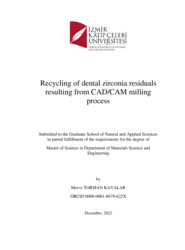Recycling of dental zirconia residuals resulting from CAD/CAM milling process Submitted
-
Eser Sahibi
Merve TORMAN KAYALAR
- Tez Danışmanı Mücahit SÜTÇÜ
-
Tür
Yüksek Lisans
- Yayın Tarihi 2022
-
Yayıncı
Fen Bilimleri Enstitüsü
- Tek Biçim Adres https://hdl.handle.net/11469/3360
-
Konu Başlıkları
Dental zirkonya blok artıkları
CAD/CAM prosesi
Dental zirkonyanın geri dönüşümü
Pre-sintered zirconia blocks stabilized with 3 mol% yttria are the most widely used dental materials in dental prostheses due to their high mechanical strength, high oxidation and wear resistance, high hardness, and excellent biocompatibility. Thanks to the processing of dental blocks with the CAD / CAM process, aesthetic restorations with excellent precision and high surface quality can be produced. However, only 30% of the blocks processed during the CAD/CAM process can be converted into products, while some of the remainder turns into dust and is collected in filters, and the other part becomes inactive as processed waste blocks. Considering the financial value of zirconia, waste zirconia in specified amounts causes a serious economic loss. From an environmental and economic point of view, there will be obvious benefits from recycling this waste and reusing it as a high value-added material. With this motivation, in this thesis study, the recycling of dental zirconia block wastes formed after the CAD/CAM processing process and their reusability in dental applications were investigated. Waste dental zirconia blocks, collected in sufficient quantity from a local dental laboratory, were pulverized and sieved below 45 μm. After the raw material characterization, the recycled dental zirconia powder was mixed with 3 mol% yttria added commercial zirconia powder in various proportions. After the prepared iii compositions were formed into pellets, they were cold isostatically pressed (CIP) under 250 MPa pressure. The prepared samples were first pre-sintered at 1000°C for 4 hours and then fully sintered at 1450°C, 1500°C and 1550°C for 2 hours. The weight and dimensional changes of the obtained ceramic bodies were calculated. Phase analysis of the samples and tetragonal to monoclinic phase changes after aging test (LTD) were detected by X-ray diffraction (XRD). Morphological properties and grain sizes of raw materials and sintered samples were determined by scanning electron microscopy (SEM). Density measurements were carried out using the Archimedes’ method. A number of mechanical tests (Vickers hardness, fracture toughness and three-point bending test) were applied to the sintered samples and the results were evaluated according to the sintering temperature and the addition of recycled zirconia powder. Comparing the findings with the samples produced entirely from commercial powder (COM) and the samples produced from the original block (OB) processed in CAD/CAM, inferences were made about the reusability of 3 mol% yttria added, pre-sintered waste dental zirconia blocks by recycling them in dental areas. Comparing the findings with samples produced entirely from commercial powder (COM) and samples produced from the original block (OB) processed in CAD/CAM, inferences were made about the reusability of pre-sintered dental zirconia blocks with 3 mol% yttria added by recycling in dental fields.
-
Koleksiyonlar
ENSTİTÜLER
FEN BİLİMLERİ ENSTİTÜSÜ

 Tam Metin
Tam Metin

